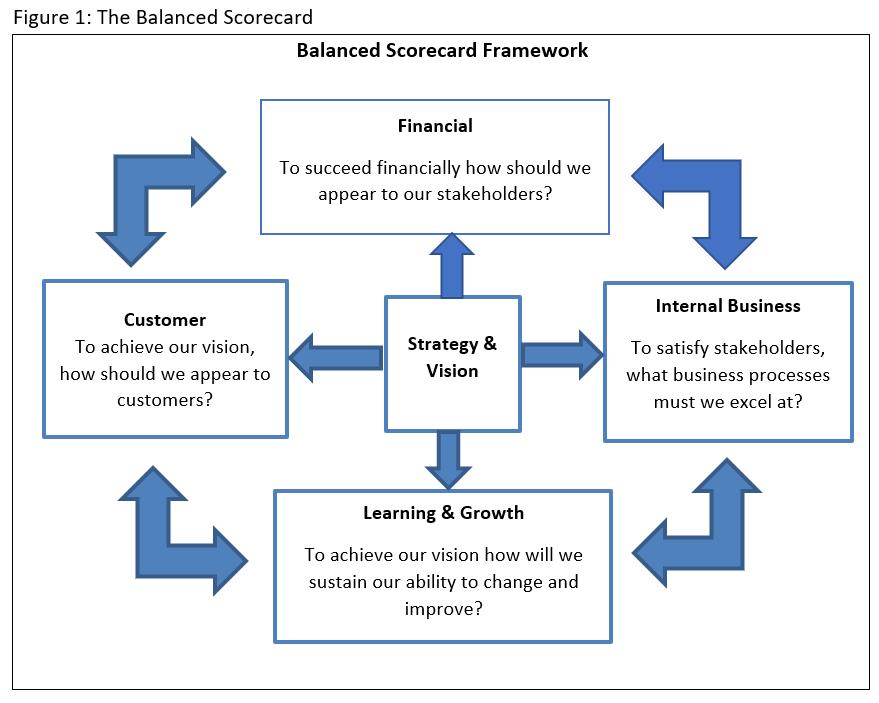Effective strategic planning requires skills, knowledge and the use of tools such as the balanced scorecard to assist with evaluation, decision making and monitoring progress. The Balanced Scorecard is a tried and tested tool for providing a balanced view of progress against your strategic plan. Read on to find out more about this useful tool.
Bite Size ‘Simple Steps’ (TLDR) – 4 Steps to Implementing the Balanced Scorecard for a SaaS Startup
- Clarify Your Strategic Objectives
- Explanation: Begin by clearly defining your strategic objectives and vision. This will serve as the foundation for your Balanced Scorecard and ensure alignment with your overall business goals. The objectives should be specific, measurable, and tied directly to your company’s long-term vision.
- Example: A SaaS startup specializing in remote collaboration tools decides that its strategic objective is to become the leading provider of seamless project management solutions for remote teams within the next three years.
2. Identify Key Performance Indicators (KPIs) Across Four Perspectives
- Explanation: Break down your strategic objectives into measurable KPIs across the four Balanced Scorecard perspectives: Financial, Customer, Internal Business Processes, and Learning & Growth. Each KPI should align with your strategic goals and provide insight into different aspects of your business.
- Example:
- Financial: Increase monthly recurring revenue (MRR) by 20% within the next year.
- Customer: Achieve a customer satisfaction score of 90% or higher.
- Internal Business Processes: Reduce software bug reports by 30% through enhanced QA processes.
- Learning & Growth: Ensure that 80% of the development team completes advanced training on new coding frameworks.
3. Set Specific Targets and Implement Monitoring Tools
- Explanation: For each KPI, set specific, time-bound targets. Implement tools and processes to monitor progress toward these targets regularly. Use a traffic light system (red, yellow, green) to easily identify areas where your startup is meeting, exceeding, or falling short of expectations.
- Example:
- Financial: Track MRR monthly using your CRM system and set a green light for a 20% increase, yellow for a 15-19% increase, and red for anything below 15%.
- Customer: Use customer feedback surveys to monitor satisfaction scores, setting green for 90% or above, yellow for 80-89%, and red for below 80%.
- Internal Business Processes: Monitor bug reports through your issue-tracking software and apply a green light for a 30% reduction, yellow for a 20-29% reduction, and red for anything below 20%.
- Learning & Growth: Track training completion rates through your learning management system (LMS), with green for 80% or higher, yellow for 70-79%, and red for below 70%.
4. Review and Adjust the Strategy Regularly
- Explanation: Regularly review the Balanced Scorecard to assess progress and make necessary adjustments. This ongoing process ensures that your strategy remains relevant and that your team is focused on the right priorities. Adjust targets and KPIs based on performance data and changing market conditions.
- Example: Quarterly reviews reveal that while customer satisfaction is high, the MRR growth is lagging. The startup decides to adjust its strategy by offering new pricing tiers and enhancing marketing efforts to attract a broader customer base, aiming to boost revenue growth.
Strategic planning
There are three key phases to strategic planning: 1. Undertaking strategic analysis to understand the current situation; 2. Strategic decision making of what to do and what not to do; 3. Putting the strategic plan into action. Each phase consists of a series of steps using specific tools and techniques to support understanding, make decisions and for successful implementation and monitoring. The balanced scorecard is one of these tools used in the stage of putting the strategic plan into action.
Central to the balanced scorecard is your strategy and vision. In order to gain the most from this model the first two strategic phases outlined above should be completed first. You will then have a clear vision and strategic direction at the heart of your balanced scorecard.
The Balanced Scorecard
The beauty of the Balanced Scorecard as a leadership and management tool lies in its relative simplicity and the alignment to your strategy and vision. It is adaptable enough to be applied to any organisation, service, or team across multiple sectors. It is easy to update, provides structure and it tells you on one page how you are performing. It can also be used to communicate the progress you are making. Sounds great doesn’t it. It is so good we have included it in our Simple Steps to Strategy book. So, what is it and how do you implement it?
Although the Balanced Scorecard (figure 1 below) was developed more than 30 years ago it remains as relevant today and is widely used across business and the public sector. Examples in the seminal papers by Kaplan and Norton (1992, 1993 and 1996) were all large companies in private industry. Gumbus and Lusier (2006) then demonstrated beneficial application for small to medium sized businesses. Since then, there have been a plethora of articles demonstrating the Balanced Scorecard’s use and value across multiple sectors, including healthcare where the tool provides a common language between administrative and medical leaders, as well as increasing the focus on patient experience and aligning organisation goals with appraisals.

The tool was developed to provide a more balanced view on performance and devised to provide senior managers with a fast but comprehensive understanding of their organization. The key performance measure for business success at the time was the financial situation of the organisation. Three other key perspectives of information on customer satisfaction, internal business processes, and learning and growth were added to financial measurement, with the view that performance targets should not be set with one sole measure.
Why is this important? An organisation can achieve short term financial success, but how do you know if this is optimal and sustainable? The internal business perspective can provide information on the efficiency of your business. The learning and growth perspective will provide information on relevant training. The financial position could be good, but if staff are not completing training which impacts their efficiency, effectiveness, or safety at work, and the business processes are not aligned, this good financial position will not be sustained. In healthcare, training ensures safety for staff and patients. In the short and longer term, lack of training becomes a safety and financial risk.
Taking the adage that the ‘customer is always right’, customer feedback should be incorporated into understanding your organisation. This can provide early insight into changes to services, whereas reporting the financial position alone may hide dissatisfied customers. Over time these dissatisfied customers will move on which could be expected to impact the future financial position. In contrast, there may be an over emphasis in teams on learning and growth to the detriment of other perspectives. Collectively, these multiple measures provide against the likelihood of unintended negative side effects of following narrow performance indicators.
The benefits of the tool derive from the four perspectives being inter-related and providing balance (Kaplan and Norton, 1992) with customer views being oriented, whilst the internal business processes aspect should have a significant impact on customer satisfaction. The perspectives offer a combination of ‘lagging indicators’ – outcome measurement of what has happened financially and with customers – and ‘leading indicators’ – those which demonstrate building capability such as training completion and business (Oliveira, 2001). They also mitigate against the likelihood of unintended negative side effects of following narrow performance indicators.
Focusing these critical measures of the four perspectives within one document, not only enables ease of identifying connections between improvement in one area and changes in another, but also promotes the tool in driving change, and benefitting employees from different cultures, languages, and operating backgrounds (Kaplan and Norton, 1993).
Each aspect has: (i) an objective with an outcome to be achieved by a specific date, (ii) a measure to determine whether this has been achieved, and (iii) a measurable performance outcome target. A traffic light system can be added to this to easily identify areas of under and over performance.
Another great feature is that objectives can be quantitative and qualitative judgements. Quantitative objectives having a specific measure such as achieve a specific financial position, or a set percentage of staff to complete training. Qualitative objectives could be used when developing a service and could include identifying the training required for the teams or establishing or exploring new ways of working.
Summary
As can be seen, the Balanced Scorecard is a useful tool in strategic planning helping leaders, teams, and organisations to understand their services, and progress made against plans. The tool provides a framework to capture various measures of performance, aligning strategy and vision with performance measures, which are presented in one place. The tool is adaptable and can be tailored to your business or team, and flexible enough to be implemented in practice with measures chosen specifically for a particular service. All of this makes it easy to set up, easy to view all key performance indicators in one place, and a means to articulate and communicate the strategy. To see how this fits in with the rest of strategy, read Simple Steps to Strategy.
References
Gumbus, A. and Lussier, R.N. (2006) Entrepreneurs use a balanced scorecard to translate strategy into performance measures. Journal of small business management, vol 44, no 3, p407 – 425
Kaplan and Norton (1992) The Balanced Scorecard – Measures that drive performance. Harvard Business Review. Jan- Feb 1992. p71 -79
Kaplan, R.S. and Norton, D.P. (1993) Putting the Balanced Scorecard to Work. Harvard Business Review. September – October 1993. p134 – 147
Kaplan, R.S. and Norton, D.P. (1996) Using the Balanced Scorecard as a Strategic Management System. Harvard Business Review. January – February 1996. p75 – 85
Kaplan, R.S. and Norton, D.P. (1996) The Balanced Scorecard: Translating strategy into action, USA, Harvard Business School Press
Oliveira, J. (2001) The Balanced Scorecard: An integrative approach to performance evaluation. Healthcare Financial Management, Vol 55, no 5, p 42 – 46





